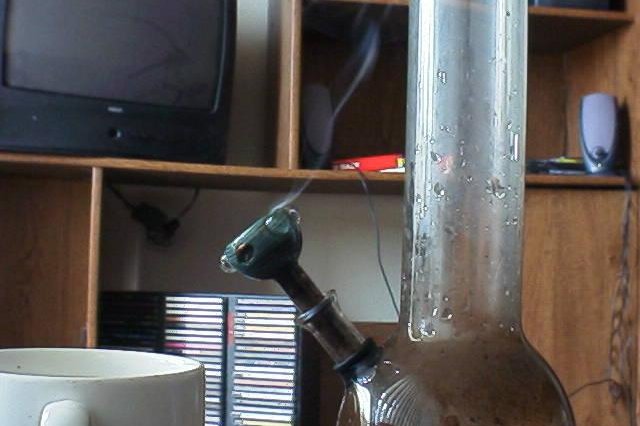Secondhand smoke from a marijuana bong creates more potentially harmful pollutants than tobacco, a new study has found. Photo by RyanW124/Wikimedia Commons
March 30 (UPI) — Smoking pot in a bong at home generates four times as much potentially harmful secondhand smoke as tobacco cigarettes, a study published Wednesday by JAMA Network Open found.
After the researchers smoked with a bong, or water pipe, for 10 minutes, concentrations of fine particulate matter, or microscopic airborne pollutants, in a roughly 200-square-foot room increased by more than 10-fold, the data showed.
Marijuana-smoking for 30 minutes in the same room led to a more than 28-fold rise in fine particulate matter levels, the researchers said.
“We did not simulate the study. This was a real hangout, a real social event,” study co-author S. Katherine Hammond said. “The smoking lasted 1 1/2 to two hours, but we measured air concentrations before and after.”
Fine particulate matter concentrations after marijuana smoking with a bong were higher than those generated with tobacco, either with cigarettes or a hookah, according to the researchers.
These higher air pollutant levels persisted for at least two hours after smoking ceased, they said.
“Bong smoking leads to extremely high and very unhealthy secondhand smoke particle concentrations,” Hammond told UPI in an email.
“Adverse health effects of particulate matter are well-established and secondhand cannabis smoke is not safe,” said Hammond, a professor of environmental health sciences at the University of California-Berkeley.
As more states across the country legalize recreational marijuana, more adults are using the drug at home, around their children, potentially exposing them to secondhand smoke, research suggests.
Secondhand smoke from traditional cigarettes has been linked with a rise in heart disease risk among children, and animal studies suggest that secondhand smoke from marijuana may be even more harmful.
Standards established by the Environmental Protection Agency indicate that exposure to ambient, or regular, indoor fine particulate matter concentrations above 35 micrograms per cubic meter in a roughly 200-square-foot room is potentially harmful.
In this study, during the first 10 minutes of marijuana-smoking with a bong, fine particulate matter concentrations increased from the EPA standard levels to 410 micrograms per cubic meter, the data showed.
After 15 minutes fine particulate matter concentrations rose to 570 mcg. per cubic meter, the researchers said.
During 30 minutes of smoking, they increased to 1,000 mcg per cubic meter before rising to as high as 2,500 mcg. per cubic meter over two hours, they said.
Across all experiments in the study, bong-smoking generated average fine particulate matter concentrations above 1,300 mcg. per cubic meter, while tobacco-smoking yielded levels of just over 399 mcg. per cubic meter, according to the researchers.
“There is no risk-free level of exposure to secondhand tobacco smoke and secondhand cannabis smoke contains similar toxins and is presumably not safe,” Hammond said.
“Secondhand cannabis smoke has the potential to cause significant disease, cannabis smoking should be included with cigarettes in clean indoor air policies,” she said.
